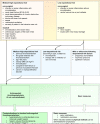Impact of electronic reminders on venous thromboprophylaxis after admissions and transfers
- PMID: 24671361
- PMCID: PMC4173166
- DOI: 10.1136/amiajnl-2013-002225
Impact of electronic reminders on venous thromboprophylaxis after admissions and transfers
Abstract
Objective: Clinical decision support has the potential to improve prevention of venous thromboembolism (VTE). The purpose of this prospective study was to analyze the effect of electronic reminders on thromboprophylaxis rates in wards to which patients were admitted and transferred. The latter was of particular interest since patient handoffs are considered to be critical safety issues.
Methods: The trial involved two study periods in the six departments of a university hospital, three of which were randomly assigned to the intervention group displaying reminders during the second period. At 6 h after admission or transfer, the algorithm checked for prophylaxis orders within 0-30 h of the patient's arrival, increasing the specificity of the displayed reminders.
Results: The significant impact of the reminders could be seen by prophylaxis orders placed 6-24 h after admission (increasing from 8.6% (223/2579) to 12% (307/2555); p<0.0001) and transfer (increasing from 2.4% (39/1616) to 3.7% (63/1682); p=0.034). In admission wards, the rate of thromboprophylaxis increased from 62.4% to 67.7% (p<0.0001), and in transfer wards it increased from 80.2% to 84.3% (p=0.0022). Overall, the rate of prophylaxis significantly increased in the intervention group from 69.2% to 74.3% (p<0.0001). No significant changes were observed in the control group. Postponing prophylaxis checks to 6 h after admissions and transfers reduced the number of reminders by 62% and thereby minimized the risk of alert fatigue.
Conclusions: The reminders improved awareness of VTE prevention in both admission and transfer wards. This approach may contribute to better quality of care and safer patient handoffs.
Keywords: Clinical; Decision Support Systems; Patient Handoff; Patient Transfer; Reminder Systems; Venous Thromboembolism.
Published by the BMJ Publishing Group Limited. For permission to use (where not already granted under a licence) please go to http://group.bmj.com/group/rights-licensing/permissions.
Figures
References
-
- Cohn SL. Prophylaxis of venous thromboembolism in the US: improving hospital performance. J Thromb Haemost 2009;7:1437–45 - PubMed
-
- Cohen AT, Tapson VF, Bergmann JF, et al. Venous thromboembolism risk and prophylaxis in the acute hospital care setting (ENDORSE study): a multinational cross-sectional study. Lancet 2008;371:387–94 - PubMed
-
- Goldhaber SZ, Tapson VF. A prospective registry of 5,451 patients with ultrasound-confirmed deep vein thrombosis. Am J Cardiol 2004;93:259–62 - PubMed
Publication types
MeSH terms
Substances
LinkOut - more resources
Full Text Sources
Other Literature Sources
Medical



